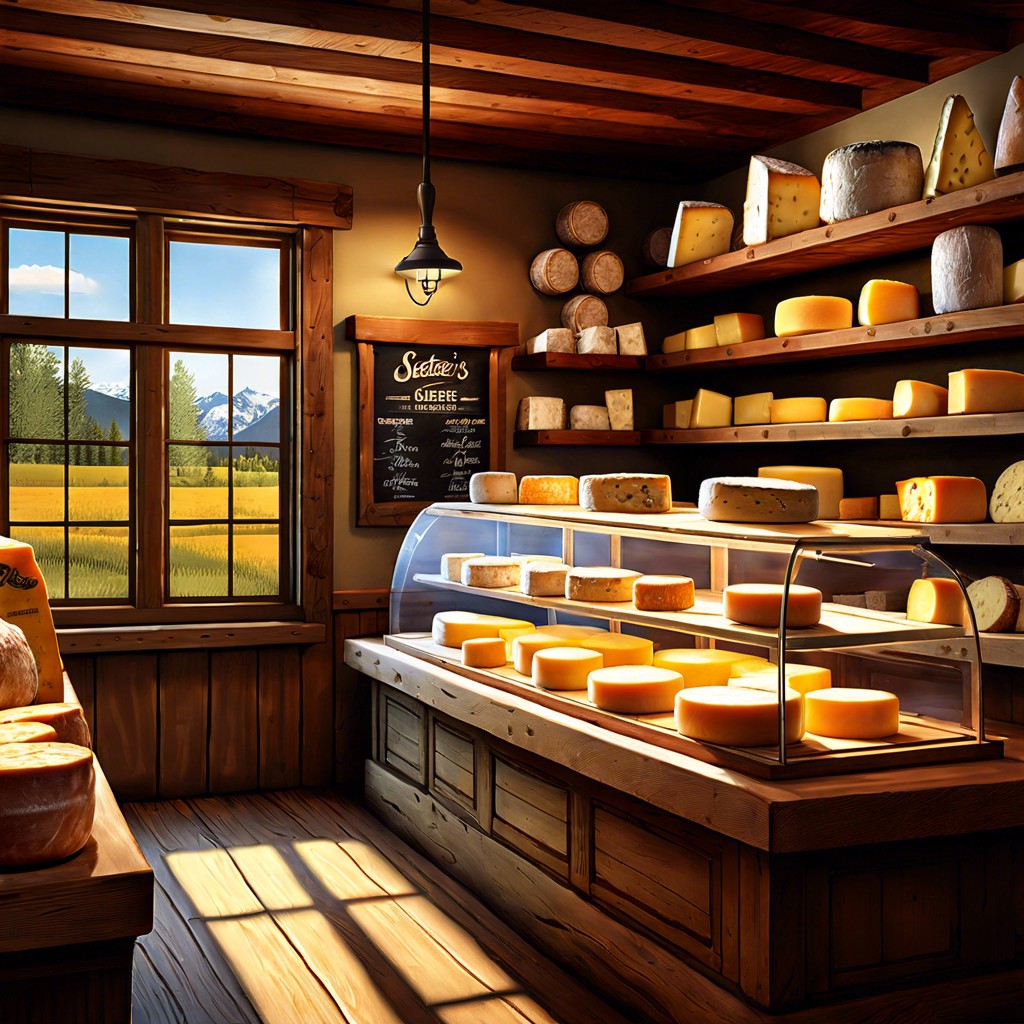Last updated on
Discover how to get Skeeter’s Roof Aged Cheese by scouring local specialty cheese shops or online gourmet retailers for this unique flavor experience.
Ever fancied becoming a rooftop cheese maestro? Well, roll up your sleeves and get ready to turn your house topper into a haven for fromage with your name on it! This guide will cover everything you need to capture a slice of dairy heaven up high—permits, tools, cellars in the sky (otherwise known as Skeeter’s infamous roof), and much more. Think of it as your cheesy adventure roadmap, sans GPS!
Key takeaways:
- Scour specialty shops or online for Skeeter’s cheese.
- Check zoning laws for rooftop cheese aging.
- Gather tools like cheese cloth and temperature control.
- Select hard cheeses; they thrive outdoors.
- Document the aging process for future reference.
Identify Location for Skeeter’s Roof

Finding Skeeter’s roof isn’t quite the cheese-venture it sounds like, but there are a few critical considerations to make along the way.
First, ensure you have the correct address—standing on the wrong roof can be a bit awkward, and possibly even illegal.
Check local zoning laws. Who knew cheese-aging could be a crime? Just make sure the roof is zoned for cheese-related activities.
Evaluate the roof’s accessibility. If it requires bungee cords or cat-like climbing skills, perhaps reconsider or call in a professional roofer with a zest for cheese.
Make sure the roof is structurally sound. It’s a no-go if stepping on it means tripping into the living room.
Next, assess for crazy wind factors. Flying gouda is dangerous and doesn’t yield a satisfactory bite.
Cars nearby? Remember—parmesan hail can leave remarkable dents.
Consider sun exposure. A sun-kissed cheese is delightful, but a sun-blasted cheese? Not so much. Balance is key.
Finally, chat with Skeeter. A quiet man of mystery on every block. Let him in on your culinary project for community spaß!
Acquire Necessary Permits or Permissions
First things first, check with local authorities about rooftop cheese aging. Imagine explaining to your neighbors why you’re scaling the heights with blocks of cheddar—might be a good story, right? But city officials might want a heads-up too.
Local regulations vary, so it’s important to understand what your area allows. Contact the zoning or building department—the folks who make wearing a hard hat indoors seem glamorous.
Insurance companies might need notice as well. A rooftop adventure with cheese doesn’t top their usual list of claims, so they might scratch their heads and adjust your coverage.
If there’s a homeowners’ association involved, play nice and fill them in. They may want to ensure your cheese escapades don’t become community legends—it’s the cheese, not you, going viral.
Gather Aging Tools: Cheese Cloth, Temperature Control
The right tools can make a world of difference in your cheese-aging quest on the roof. Picture yourself as a cheese-aging wizard, sans the funny hat. Here’s what you need to become the master of mold:
Cheese cloth: Think of it as a nice, breathable blanket for your cheese. It keeps unwanted dirt and critters out while allowing the cheese to breathe. This is essential unless you’re going for that crunchy surprise—a flavor few appreciate in their Brie.
Temperature control: Your cheese is as fussy about temperature as a cat is about which side of the door it wants to be on. Optimal conditions usually range between 50-60 degrees Fahrenheit. Too hot, and you’ll have a meltdown. Too cold, and your cheese may turn into a reluctant sloth, refusing to age gracefully.
Monitor these elements, and you’ll be well on your way to perfecting rooftop cheesecraft. Remember, your cheese can be as temperamental as a drama queen, so care and attention are paramount.
Select Appropriate Cheese Types for Aging
When considering which cheeses to age on the roof, it’s crucial to choose varieties that not only embrace aging but thrive on a bit of outdoor adventure. Cheddar, Gruyère, and Gouda are fine candidates that love developing complex flavors over time. Just like some people mellow with age, these cheeses have the potential to achieve extraordinary depth.
Some cheeses, however, prefer the confines of a controlled environment, much like your introverted uncle. Fresh cheeses like mozzarella or ricotta won’t do as well outside; they’re the delicate type, prone to tantrums if left out too long.
Hard and semi-hard cheeses are your best bet. These sturdy fellows can withstand fluctuations in temperature and humidity, making them the rugged outdoorsmen of the cheese world. Think Indiana Jones with a cheesy flair—and fewer snakes.
Remember to consider the size of your cheese, too. Larger wheels age more evenly, like a balding head, while smaller ones can get a bit out of balance.
Finally, blue cheese is a wildcard. It’s already accustomed to living with mold, so adding a bit more character from the elements could enhance its bravado. Just be prepared for some colorful commentary from your neighbors.
Set Up Dedicated Cheese Aging Area On Roof
Consider the roof’s personality—it’s like setting up a spa day for cheese. First, find a spot on the roof that offers shade and cover, just enough to let the cheese breathe without sunbathing. Too much sun, and the cheese will turn into a hot mess.
Then, create a stable platform. Uneven surfaces will give your cheese a rollercoaster ride it didn’t sign up for. Think patio furniture, minus the fashion statement.
Control the environment. The cheese deserves a cool breeze, like a tiny fan in a cheese opera house. Invest in some mesh screens to protect from wildlife—because nothing says ‘bon appétit’ like an uninvited feathered friend.
Lastly, ensure airflow. Love is in the air—and so should be the ventilation around your cheese. Air movement keeps things fresh while preventing unwanted residents like mold spores.
Monitor Weather Conditions and Adapt As Needed
Keeping an eye on Mother Nature is pivotal. Unpredictable weather can easily convert your cheese project into a fondue feast that nobody wants!
– Temperature fluctuations impact aging. Cheese is like a Goldilocks diva—it can’t be too hot or too cold. Aim for a stable climate.
– Rain is not a cheese shower. Refrigerators may have cheese drawers, but roofs don’t. Moisture may help your plants, but it will turn your cheese into a science experiment.
– Wind is an unruly ingredient. Nobody wants wind-ripened cheddar unless you’re aiming for a new culinary disaster. Secure cheese to prevent it from rolling away like an adventurous snack.
Adaptation is key. Think of it like a game of Roof Cheese Survivor. Outwit, outplay, outlast the weather!
Check Cheese Regularly for Changes or Mold
Be vigilant, cheese whisperer. Not all molds are friendly, but some hold the key to flavor that would make even a gourmet mouse weep.
Keep these quick pointers in mind:
First, inspect your cheese regularly; it’s not a toddler, but it still needs attention. Funky colors or overly furry bits? Those are signs you might want to channel your inner cheese surgeon.
Stick to the schedule. Frequent visits ensure you spot changes in time, like varying textures or aromatic evolutions. Your nose could be your best tool here; if it wrinkles its imaginary nose at a scent, investigate further.
Take notes and photos if needed! Yes, it’ll make you feel like a cheese detective, but if something goes wrong, you’ll thank your past self for clues.
Rotate the cheese every few days. Not because it’s bored, but to ensure even aging. It needs a view of all four corners of the sky, after all.
Lastly, if in doubt, reach out to experts. They can provide mold wisdom like a sage in a bluesy robe. Remember, edible art requires a bit of perseverance and luck. So, put on your best cheese cape and embrace your inner fromage hero.
Rotate Cheese to Ensure Even Aging
As your cheese embarks on its glamorous aging journey atop Skeeter’s roof, you’ll need to give it a gentle nudge now and then. Think of it as turning sides at a sunbathing session.
Rotating cheese regularly is akin to ensuring everyone gets an equal share of the spotlight. Uneven exposure could lead to one side feeling a bit… neglected.
Here are some points to keep in mind:
- Start with a consistent rotation schedule, perhaps every few days.
- Notice any early signs of uneven aging or mystery mold, and adjust rotation as needed.
- Ensure surfaces are clean to avoid unintended science experiments.
Gentle and attentive rotation will promote uniform development of flavors and texture, ensuring your roof-aged fromage turns out as fabulous as a red carpet appearance.
Document Aging Process for Future Reference
Keeping track of your roof-top cheese adventures can prevent chaos and unwanted surprises. Imagine using your ladder one day and discovering a cheese colony or worse—a cheese rebellion.
Documenting your process helps in understanding what works and what doesn’t. Record the temperature and weather conditions when you set the cheese up there; it might save you from a stormy cheese disaster.
Take notes on the timeline. Did the cheese start smelling like your socks after three days or three weeks? That’s gold for future endeavors.
Acknowledge any surprise guests: birds, squirrels, the neighbor’s overly curious cat. They might add some unexpected flavor—literally.
Photograph your cheese’s progress. A picture is worth a thousand cheesy words and can be amusing at parties.
With this information, you’ll not only avoid rookie mistakes but might just become the neighborhood’s cheese guru.
Safely Transport Aged Cheese From Roof
The time has come to bring down that prized, roof-aged cheese. Avoid letting it tumble down like a runaway cheese wheel at a county fair.
First on your checklist: attire. Wear shoes with good grip to prevent any missteps. No one wants a Gouda rescue drama.
Use a sturdy basket or container. Line it with soft cloth, like you’re tucking in a baby. This prevents the cheese from bouncing around.
Employ a pulley system or a trusty ladder-side companion to pass down the cheese. Avoid anything that resembles juggling.
Guard against weather surprises—ensure it’s a clear day, as slippery shingles could turn into a comedic slip-n-slide.
Finally, store this culinary masterpiece in a cool area promptly. Remember, it’s been through a lot up there.




